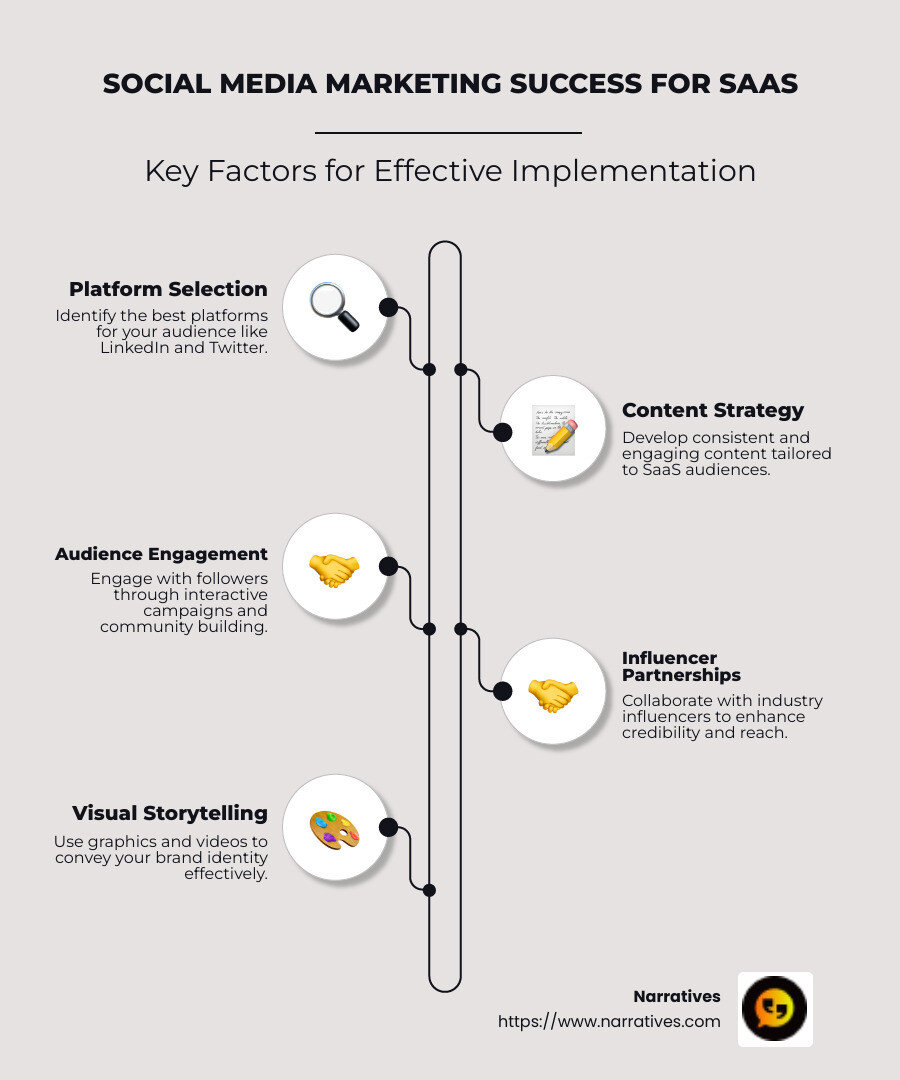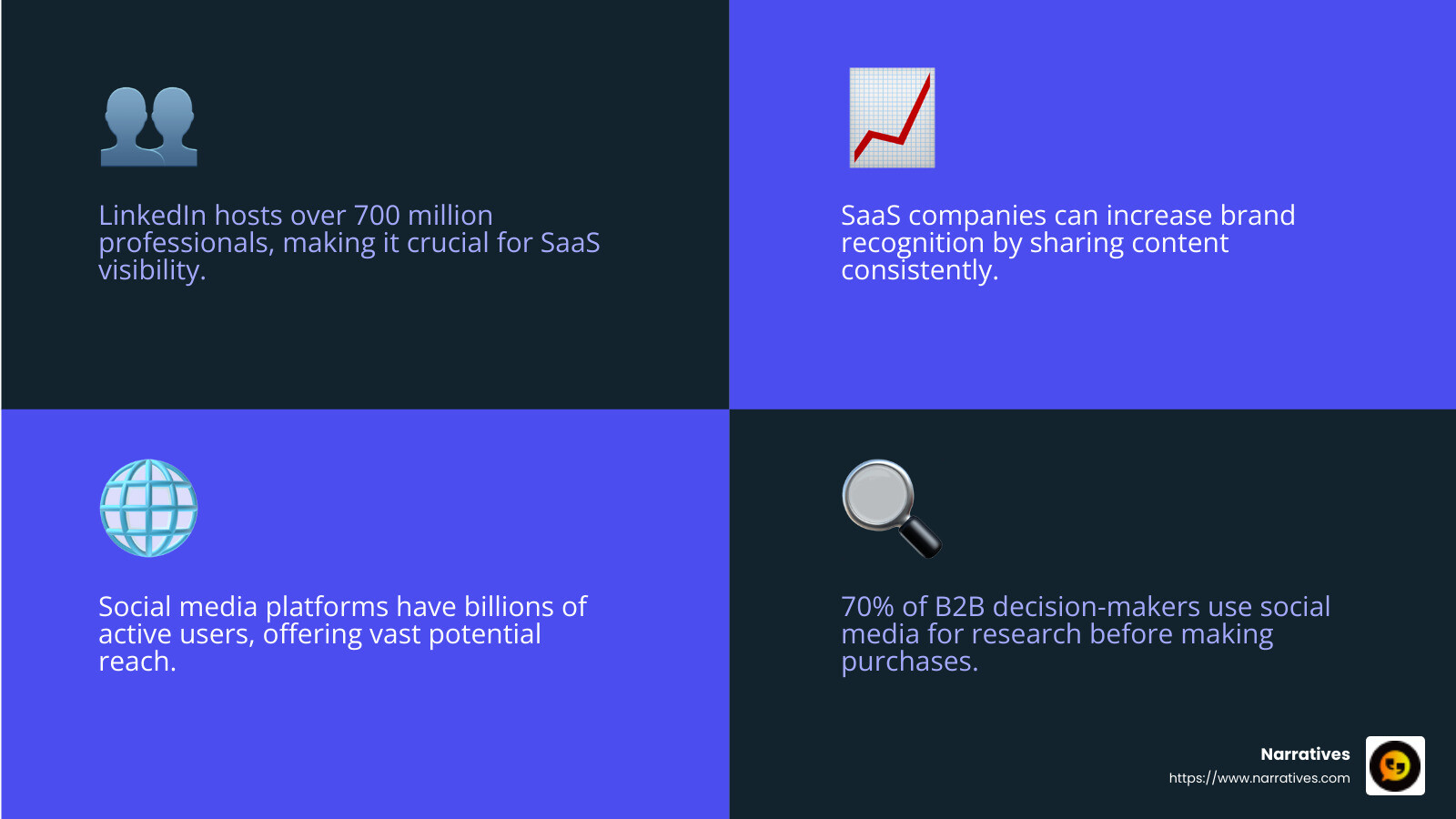SaaS Success: Mastering Social Media Marketing Strategies

Social media marketing for saas has become a game-changer in the tech world, allowing companies to connect with their audience like never before. In today's digital arena, SaaS products are as plentiful as the stars in a clear night sky, making it crucial for your software solution to shine brightly. So, how can SaaS businesses effectively use social media to stand out, attract, and convert the right audience? Here's a quick rundown to get you started:
- Build brand visibility by showcasing your unique selling points.
- Engage with your audience through consistent and relatable content.
- Generate quality leads with targeted campaigns and influencer collaborations.
- Share success stories and testimonials to build trust and credibility.
Social media platforms offer an exceptional opportunity for SaaS companies to illustrate the value of their products and foster a loyal community. Whether you're running a budding startup or an established player, these digital channels are indispensable for scalable growth.

Important social media marketing for saas terms:
- social media marketing for music artists
- social media management strategy
- social media content for marketing agency
Why Social Media Marketing is Essential for SaaS
In social media marketing for SaaS, brand visibility, lead generation, and audience engagement are the holy trinity. Let's explore why these elements are vital for success.
Brand Visibility
Social media platforms are busy with billions of users. For SaaS companies, this is a golden opportunity to increase brand visibility. By consistently sharing valuable content, your brand becomes more recognizable and trusted.
Consider LinkedIn, where a significant number of SaaS decision-makers are active. By leveraging this platform, you can showcase your expertise and solutions, making your brand top-of-mind when prospects are ready to make a purchase.

Lead Generation
Generating leads is a critical goal for any SaaS company. Social media is a powerful tool for attracting potential customers. By using targeted advertising and engaging content, you can reach individuals who are genuinely interested in your product.
For example, running a campaign on Twitter with hashtags related to common pain points your product solves can make your brand more findable. YouTube also offers an excellent platform to demonstrate your product's capabilities through informative videos, drawing in prospects who prefer visual content.
Audience Engagement
Engagement is more than just likes and shares; it's about building relationships. When you engage with your audience, you show them you care. This can be achieved through personalized responses, interactive content, and community-building efforts.
Quora and Reddit are excellent platforms for engaging with potential customers by answering questions and participating in discussions related to your industry. This not only establishes your authority but also fosters trust among your audience.
In conclusion, social media marketing for SaaS is not just a trend—it's an essential strategy. By focusing on brand visibility, lead generation, and audience engagement, you can ensure your SaaS company thrives in the competitive digital landscape.
Top Strategies for SaaS Social Media Marketing
In the world of social media marketing for SaaS, staying ahead means embracing strategies that connect, engage, and convert. Here, we'll explore five key strategies: content calendar, audience personas, influencer partnerships, interactive campaigns, and visual storytelling.
Strategic Content Calendar
A well-planned content calendar is your roadmap to consistency and engagement. It ensures that your social media posts are timely and relevant, aligning with industry events, product launches, and trending topics.
- Mix it up: Combine promotional content with educational posts that address your audience's challenges. Sprinkle in fun content to keep things lively.
- Schedule smartly: Use tools like Hootsuite or Buffer to automate postings. This keeps your brand visible without the daily grind of content creation.
Planning ahead with a content calendar helps maintain a steady flow of content, keeping your audience engaged and your brand top-of-mind.
Audience Persona Optimization
Understanding your audience is crucial. Audience personas are detailed profiles that highlight your target market's demographics, needs, and online behaviors.
- Analyze and adapt: Use social media analytics to refine these personas. Identify what content resonates and adjust your strategies accordingly.
- Speak directly: Tailor your messaging to address specific pain points and preferences, positioning your SaaS product as the ideal solution.
By continuously optimizing your audience personas, your content becomes more targeted and effective.
Influencer Partnerships in SaaS
Influencer partnerships can lift your brand's credibility and reach. People trust recommendations from those they perceive as experts.
- Find the right fit: Look for influencers whose audience aligns with your target market and brand values.
- Build relationships: Collaborate on content that educates and entertains, rather than just promotes.
These partnerships can broaden your reach and connect you with audiences who already trust the influencer's recommendations.
Interactive Campaigns for SaaS
Interactive campaigns transform passive viewers into active participants, fostering a sense of community.
- Engage creatively: Launch polls, quizzes, or contests that encourage user participation. User-generated content (UGC) adds authenticity and builds community.
- Learn from engagement: Track participation rates and shares to refine future campaigns.
Interactive experiences not only boost engagement but also provide valuable insights into your audience's preferences.
Visual Storytelling Excellence
Humans are visual creatures, and compelling visuals can leave a lasting impact.
- Invest in quality: Use high-quality graphics, infographics, and videos to tell your brand story.
- Maintain consistency: A consistent visual theme across platforms strengthens brand identity.
Visual storytelling is not just about aesthetics; it's about creating an emotional connection with your audience.
By integrating these strategies into your social media marketing for SaaS efforts, you can build a robust online presence that resonates with your audience and drives growth.
Strategic Content Calendar for SaaS
A strategic content calendar is essential for any SaaS company aiming to maintain a consistent and engaging social media presence. It's more than just a schedule; it's a blueprint for success in the competitive world of social media marketing for SaaS.
Planning for Success
To start, a content calendar helps you plan your social media posts well in advance. This planning ensures that your content aligns with key industry events, product launches, and trending topics. By organizing your content around these milestones, you can maximize its relevance and impact.
Diverse Content Mix: Your calendar should include a mix of promotional, educational, and fun content. This variety keeps your audience interested and engaged. Educational posts can address common challenges your audience faces, offering solutions and insights.
Key Dates and Events: Mark important dates like industry conferences or product release dates. This helps you craft timely content that resonates with your audience.
Consistency is Key
Consistency is crucial in building trust and recognition. A well-maintained content calendar ensures that your posts are regular and predictable, which helps keep your brand top-of-mind for your audience.
Automate for Efficiency: Use scheduling tools like Hootsuite or Buffer to automate your posts. This not only saves time but also ensures that your content goes live at optimal times for engagement.
Steady Flow: A consistent posting schedule fosters a steady flow of content, reducing the pressure of daily content creation and allowing you to focus on quality over quantity.
Engaging Your Audience
Engagement is the ultimate goal of any social media strategy. A content calendar can help you plan content that sparks interaction and conversation.
Interactive Elements: Incorporate interactive elements like polls, quizzes, or Q&A sessions into your calendar. These activities encourage audience participation and can lead to valuable insights.
Monitor and Adapt: Regularly review engagement metrics to see which types of content perform best. Use this data to refine your future content plans.
By implementing a strategic content calendar, SaaS companies can ensure their social media marketing efforts are both effective and efficient, leading to increased brand visibility and stronger audience connections.
Audience Persona Optimization
To excel in social media marketing for SaaS, understanding your audience is key. This is where audience persona optimization comes into play. By defining and refining your audience personas, you can tailor your content to meet the specific needs and behaviors of your target market.
Demographics: Knowing Who They Are
Start by identifying the basic demographics of your ideal customers. This includes age, gender, location, and occupation. These factors help you understand who is most likely to benefit from your SaaS product. For example, insights reveal that investments in SaaS services are growing, indicating a broadening audience base.
Age and Gender: Knowing if your audience is primarily millennials or Gen Z can shape your content style and platform choice. Instagram, for instance, is popular with teens and millennials, making it ideal for reaching younger demographics.
Location: Understanding where your audience is located can guide your posting schedule. If your SaaS product has a global reach, managing different time zones effectively is crucial.
Needs: Solving Their Problems
Once you know who your audience is, the next step is understanding their needs. What challenges do they face, and how can your SaaS product help? This is crucial for creating content that resonates.
Pain Points: Identify the specific problems your audience wants to solve. Whether it's streamlining business processes or enhancing productivity, your content should highlight how your SaaS product addresses these issues.
Solutions Offered: Use testimonials and case studies to show real-world applications of your product. These stories add credibility and demonstrate the tangible benefits of your solution.
Behaviors: Understanding How They Engage
Finally, consider how your audience interacts with social media. This includes the platforms they use, the type of content they engage with, and their online habits.
Platform Preferences: Different platforms attract different audiences. LinkedIn is excellent for B2B engagement, while YouTube is perfect for video content. Choose platforms based on where your audience is most active.
Content Interaction: Analyze engagement metrics to see what content types perform best. If your audience prefers videos, consider creating more video content. As noted, video is increasingly popular, with platforms like TikTok leading the charge.
By optimizing your audience personas, you ensure that your social media marketing for SaaS speaks directly to the right people. This targeted approach not only improves engagement but also positions your SaaS product as the perfect solution for your audience's needs.
Influencer Partnerships in SaaS
In social media marketing for SaaS, influencer partnerships can be a game-changer. They help build credibility and trust with your audience, which is vital for success. Let's explore how these partnerships work and why they're so effective.
Credibility: Leveraging Expert Voices
People trust experts. When an influencer who is respected in your industry endorses your SaaS product, it adds a layer of credibility that can be hard to achieve otherwise. According to research, people are more likely to trust recommendations from individuals they perceive as knowledgeable and trustworthy.
Industry Experts: Look for influencers who are already talking about topics related to your SaaS product. Their audience is likely interested in your offerings, making them ideal partners.
Authentic Endorsements: Genuine collaborations, such as behind-the-scenes looks or testimonials, can highlight the real-world impact of your product. This authenticity resonates with audiences and builds trust.
Audience Trust: Building Relationships
Influencers have built-in audiences who trust their opinions. By partnering with them, you tap into this trust. It's like getting a stamp of approval from someone your audience already respects.
Alignment with Brand Values: Ensure that the influencers you choose align with your brand values. This alignment strengthens the message and ensures it resonates with their followers.
Engagement and Interaction: Influencers often have high engagement rates. Their followers are not just passive viewers; they actively interact with content. This interaction can drive more engagement for your SaaS brand.
Collaboration: Creating Valuable Content Together
Successful influencer partnerships are more than just promotion—they're about collaboration. Work with influencers to create content that is both educational and entertaining.
Co-Created Content: Team up with influencers to produce content that showcases your SaaS product's benefits. Whether it's a how-to video or a joint webinar, this content can provide value to both your audiences.
Storytelling: Use storytelling to connect on an emotional level. Show how your product solves problems or improves lives, making the collaboration feel more like a shared journey than a sales pitch.
By focusing on credibility, audience trust, and collaboration, influencer partnerships can significantly improve your social media marketing for SaaS. They not only expand your reach but also deepen the connection with your audience, turning potential leads into loyal customers.
Next, let's dive into how interactive campaigns can further boost engagement and community building.
Interactive Campaigns for SaaS
Engaging your audience is key to successful social media marketing for SaaS. One effective way to do this is through interactive campaigns. These campaigns not only boost user participation but also help in building a strong community around your brand.
User Participation: Making Engagement Fun
Interactive campaigns invite users to be a part of the conversation rather than just passive observers. This involvement can significantly increase engagement levels.
Polls and Quizzes: Launching polls or quizzes can spark interest and invite your audience to share their thoughts. For instance, a fun quiz about industry knowledge or a poll about new features can drive interaction.
Contests and Challenges: Host contests that encourage users to create content using your SaaS product. This could be a design challenge or a video contest. The goal is to make participation enjoyable and rewarding.
Community Building: Creating a Sense of Belonging
Building a community around your SaaS brand fosters loyalty and long-term engagement. Interactive campaigns can be a cornerstone of this effort.
User-Generated Content (UGC): Encourage your users to share their experiences with your product. UGC not only builds authenticity but also strengthens the sense of community. When users see others like them using and enjoying your product, it creates a bond.
Feedback and Suggestions: Use interactive campaigns to gather feedback. Ask your community what features they’d like to see next. This not only makes users feel valued but also provides you with valuable insights.
Engagement: Keeping the Conversation Going
Interactive campaigns keep the conversation going long after the initial post. They invite ongoing participation and dialogue.
Live Q&A Sessions: Host live sessions where users can ask questions and get real-time answers. This direct interaction can deepen engagement and provide immediate value to your audience.
Storytelling with Visuals: Use captivating visuals to tell stories about how your SaaS product is making a difference. Infographics, videos, and images can convey complex ideas simply and effectively, keeping users interested and engaged.
By focusing on user participation, community building, and engagement, interactive campaigns can significantly improve your social media marketing for SaaS. They transform your social media platforms into vibrant communities where users feel connected and valued.
Next, we'll explore the art of visual storytelling and how it can lift your brand identity.
Visual Storytelling Excellence
Visual storytelling is a powerful tool in social media marketing for SaaS. It helps convey complex ideas simply and builds a strong brand identity. Let's explore how you can use graphics and videos to tell your brand's story effectively.
Graphics: The Power of Visuals
Graphics are not just about aesthetics. They play a crucial role in communicating your brand's message.
Infographics: These are perfect for breaking down complex information. For example, a well-designed infographic can illustrate how your SaaS product solves a specific problem. It's a quick way to educate and engage your audience.
Consistent Visual Theme: Maintaining a consistent visual style across all platforms is key. It helps in creating a recognizable brand identity. When users see your posts, they should immediately associate them with your brand.
Videos: Captivating and Engaging
Videos are incredibly engaging and can capture your audience's attention quickly. They are ideal for telling stories that resonate.
Product Demos: Show, don't just tell. Use videos to demonstrate the features and benefits of your SaaS product. A short, engaging video can showcase how your product works and its impact on users.
Customer Testimonials: Videos of happy customers sharing their experiences can be powerful. They add credibility and show real-world applications of your product. This builds trust and encourages potential customers to take action.
Brand Identity: Crafting a Memorable Presence
Your brand identity is what sets you apart. Visual storytelling plays a vital role in establishing and reinforcing this identity.
Emotional Connection: Use visuals to evoke emotions. Show not just what your product does, but how it makes users feel. This emotional connection makes your brand more relatable and memorable.
Storytelling: Every image or video should tell a story. Whether it's a success story of a customer or a behind-the-scenes look at your team, make sure it aligns with your brand's narrative.
By investing in high-quality graphics and videos, and maintaining a consistent brand identity, you can lift your social media marketing for SaaS. Visual storytelling not only makes your content more engaging but also builds a lasting impression with your audience.
Next, let's explore the best social media platforms for SaaS success and how to leverage them effectively.
Social Media Platforms for SaaS Success
Choosing the right platform is crucial in social media marketing for SaaS. Each platform offers unique features and audiences. Let's explore how to leverage them effectively.
LinkedIn: The B2B Powerhouse
LinkedIn is the go-to platform for SaaS companies targeting businesses. It's where professionals network and share industry insights.
Thought Leadership: Share articles, infographics, and case studies to establish your brand as an industry leader.
LinkedIn Groups: Join or create groups related to your industry. Engage with members by sharing valuable content and starting discussions.
Advertising: Use LinkedIn's targeted advertising options to reach decision-makers in specific industries.
Facebook: Broad Reach and Engagement
Facebook offers a mix of organic and paid opportunities for SaaS marketing.
Community Building: Create a Facebook group for your users. It's a great way to foster a community and engage with your audience.
Facebook Ads: Leverage Facebook's advanced targeting options to reach specific demographics interested in your SaaS product.
Instagram: Visual Storytelling
Instagram is perfect for brands that can leverage visual content.
Behind-the-Scenes: Share photos and stories that give a glimpse into your company culture and team.
Instagram Stories: Use this feature for quick updates, user-generated content, and interactive polls.
Twitter: Real-Time Engagement
Twitter is ideal for real-time updates and conversations.
Hashtags: Use relevant hashtags to increase findability. Create your own hashtags around common pain points your SaaS solves.
Engagement: Respond to mentions and join industry conversations to engage with your audience.
YouTube: Video Content Hub
YouTube is the best platform for hosting video content.
Tutorials and Demos: Create videos that demonstrate how your SaaS product works. This helps potential customers understand your product better.
Customer Testimonials: Share video testimonials to build trust and credibility.
Quora: Knowledge Sharing
Quora is a platform for answering questions and showcasing expertise.
Answer Questions: Find questions related to your industry and provide insightful answers. This positions your brand as an expert in the field.
Monitor Topics: Keep an eye on discussions related to your SaaS product and engage where relevant.
Reddit: Community Interaction
Reddit is a platform for niche communities and discussions.
Subreddits: Join subreddits related to your industry. Share content and engage in discussions to build authority and trust.
Content Sharing: Use Reddit to share valuable content that resonates with your target audience.
By strategically using these platforms, you can maximize the reach and impact of your social media marketing for SaaS. Next, we'll dig into the differences between paid and organic strategies to optimize your efforts.
Paid vs. Organic Social Media Strategies
When diving into social media marketing for SaaS, understanding the differences between paid and organic strategies is key. Each has its own strengths, and knowing how to leverage them can amplify your marketing efforts.
Cost Efficiency
Organic Social Media:
Organic posts are free. They allow you to engage with your audience without spending a dime. This is perfect for startups or companies looking to build a community over time. You can share updates, engage with followers, and build brand identity without incurring costs.
Paid Social Media:
Paid strategies, on the other hand, offer cost efficiency in terms of return on investment. You only pay for the actions you define as goals, such as clicks or leads. This means you can control your budget and ensure that every dollar spent is working towards achieving a specific outcome.
Targeting
Organic Social Media:
While organic strategies rely on your existing followers and their networks, they are less precise in targeting specific demographics. However, they offer the advantage of reaching an audience that is already interested in your content.
Paid Social Media:
Paid strategies shine in targeting. You can define your audience based on location, age, interests, and more. This precision ensures your content reaches the right people, making it ideal for campaigns aimed at specific user segments or new markets.
Community Building
Organic Social Media:
Building a community is where organic strategies truly excel. By consistently engaging with your audience through comments, shares, and user-generated content, you foster a sense of belonging and loyalty. Social media platforms like Facebook and LinkedIn are perfect for creating groups and forums where users can interact and share experiences.
Paid Social Media:
While paid strategies are more transactional, they can still support community building. By promoting content that encourages interaction or invites users to join groups, you can expand your community quickly. Retargeting ads can also remind existing community members of ongoing discussions or events.
By combining both paid and organic strategies, SaaS companies can create a balanced approach that leverages the strengths of each. Organic efforts build trust and community, while paid strategies improve reach and precision. Next, we'll explore how to optimize your content calendar to maintain consistency and engagement.
Frequently Asked Questions about Social Media Marketing for SaaS
What are the benefits of social media marketing for SaaS?
Lead Generation:
Social media is a goldmine for generating leads. Platforms like LinkedIn and Twitter allow SaaS companies to connect with decision-makers directly. By sharing valuable content and engaging in meaningful conversations, you can attract potential customers who are genuinely interested in your product.
Brand Awareness:
Building brand awareness is crucial for any SaaS business. Social media platforms provide a stage to showcase your brand's personality and values. Through consistent posting and engaging content, you can make your brand recognizable and trusted in your industry.
How do you create a successful social media strategy for SaaS?
Research:
Start with research. Understand your audience's needs, preferences, and behaviors. This will help you tailor your content to what resonates with them. Tools like social media analytics can provide insights into what works and what doesn’t.
Planning:
Create a strategic plan. Outline your goals and decide which platforms to focus on. For SaaS, LinkedIn is often a top choice due to its professional network. Twitter is great for real-time engagement, and YouTube excels in video content.
Execution:
Execute your plan with consistency. Use a content calendar to schedule posts and maintain a steady presence. Engage with your audience regularly by responding to comments and participating in discussions. This keeps your brand top-of-mind and builds a loyal community.
What platforms are best for SaaS social media marketing?
LinkedIn:
LinkedIn is ideal for B2B SaaS marketing. It connects you with professionals and industry leaders. Use it to share thought leadership content, case studies, and company updates. It's also a platform where you can run targeted ads to reach specific job titles or industries.
Twitter:
Twitter is perfect for engaging in real-time conversations. Use it to join industry discussions, share quick updates, and connect with influencers. Hashtags can help increase your visibility and findability on this platform.
YouTube:
YouTube is a powerhouse for video content. Create tutorials, product demos, and customer testimonials. Video content is highly engaging and can showcase your SaaS product in action. It's a great way to visually communicate your brand story and product benefits.
By leveraging these platforms effectively, SaaS companies can maximize their social media impact. Up next, we'll dig into visual storytelling excellence and how it can lift your brand identity.
Conclusion
As we wrap up our exploration of social media marketing for SaaS, it's evident that the power lies not just in the platforms or the strategies, but in the stories we tell. At Narratives, we believe in the transformative power of storytelling. Our mission is to amplify the voices of non-profits and purpose-driven organizations, helping them to share their impact stories in a way that resonates and inspires action.
Narratives and Storytelling
Storytelling is at the heart of what we do. It's about more than just sharing facts; it's about creating a connection. In the SaaS world, storytelling can turn complex software features into relatable, human experiences. By sharing customer success stories and impactful case studies, you build trust and authenticity.
Non-Profit Partnerships
Our partnerships with non-profits are a testament to the impact of collaborative storytelling. By working together, we can lift underrepresented voices and shine a light on important social issues. This not only helps non-profits gain visibility but also fosters a sense of community and shared purpose.
Social Impact
Social media is a powerful tool for driving social impact. It's a space where stories can be shared widely and quickly, reaching audiences that might otherwise be inaccessible. By using social media strategically, SaaS companies can contribute to social good, aligning their brand with causes that matter and building a loyal community around shared values.
In conclusion, whether you're a SaaS company looking to expand your reach or a non-profit aiming to amplify your message, the key is in crafting compelling narratives that engage and inspire. At Narratives, we are committed to helping you tell those stories. If you're ready to lift your storytelling and make a meaningful impact, partner with us.
Together, we can create stories that not only inform but also transform.


